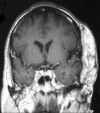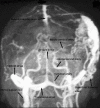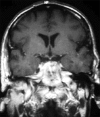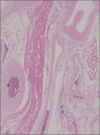Giant non-traumatic arteriovenous malformation of the scalp
- PMID: 22639692
- PMCID: PMC3358958
- DOI: 10.4103/1793-5482.95698
Giant non-traumatic arteriovenous malformation of the scalp
Abstract
Arteriovenous malformation (AVM) of the scalp is an uncommon entity. Its management is difficult because of its high shunt flow, complex vascular anatomy, and possible cosmetic complications. The etiology of scalp AVMs may be spontaneous or traumatic. Clinical symptoms frequently include pulsatile mass, headache, local pain, tinnitus; and less frequently, hemorrhage and necrosis. Selective angiography is the most significant diagnosis method. Surgical excision is especially effective in AVMs and the most frequently used treatment method. In this article, we discussed the clinical features and surgical management of scalp AVMs.
Keywords: Arteriovenous malformation; diagnosis; scalp; treatment.
Conflict of interest statement
Figures




References
-
- Senoglu M, Yasim A, Gokce M, Senoglu N. Nontraumatic scalp arteriovenous fistula in an adult: Technical report on an illustrative case. Surg Neurol. 2008;70:194–7. - PubMed
-
- Muthukumar N, Rajagopal V, Manoharan AV, Durairaj N. Surgical management of cirsoid aneurysms. Acta Neurochir (Wien) 2002;144:349–56. - PubMed
-
- Shenoy SN, Raja A. Scalp arteriovenous malformations. Neurol India. 2004;52:478–81. - PubMed
-
- Massimi L, De Bonis P, Esposito G, Novegno F, Pettorini B, Tamburrini G, et al. Vertex scalp mass as presenting sign of a complex intracranial vascular malformation. J Neurosurg Pediatr. 2009;3:307–10. - PubMed
-
- Heilman CB, Kwan ES, Klucznik RP, Cohen AR. Elimination of a cirsoid aneurysm of the scalp by direct percutaneous embolization with thrombogenic coils.Case report. J Neurosurg. 1990;73:296–300. - PubMed

